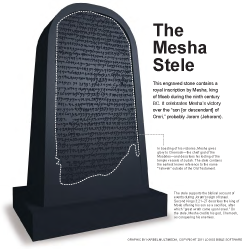15:1–16:14 Unlike most of the other oracles against the nations, which gloat over their eventual downfall, this oracle about Moab is sympathetic. In v. 5 and 16:9–11, Yahweh laments over the misfortune of Moab. Still, the same sin of pride and arrogance requires judgment. Jeremiah offers a similar prophecy against Moab in Jer 48. |
15:1 An oracle of Moab In many oracles against the nations, a heading like this indicates a specific recipient (see Isa 13:1).
 Oracles against the Nations Table
Oracles against the Nations Table
Moab |
Ar is devastated in a night, Moab Locations throughout the territory of Moab are named, beginning with their main center of power in the south and moving northward. The northern cities of Moab are destroyed; the southern cities are depicted mourning over the loss, while fugitives flee southward.
15:2 Dibon Located in disputed territory; Israel claimed the territory east of the Jordan for the tribes of Reuben and Gad. Historically, those areas were predominantly controlled by Moab and Ammon. See Num 32:34 and 33:44–45.
the high places The temple and high places indicate sites of worship for Chemosh, the god of Moab. He is mentioned in 1 Kgs 11:7, 33 as one of the foreign deities whose worship was promoted in Israel. The deity is mentioned outside the Bible in an inscription attributed to Mesha, king of Moab (see 2 Kgs 3:4–5).
Every head is bald A sign of mourning (see Isa 22:12).
15:3 They gird themselves with sackcloth A symbol of despair, humiliation, and mourning (Jer 48:37).
wails, going down in weeping See Jer 48:38.
15:4 Heshbon and Elealeh Cities in the northern part of Moab’s territory that may have been built by Israel (Num 32:37). See note on Isa 15:1.
15:5 My heart cries out for Moab Yahweh Himself empathizes with the Moabites.
Zoar, to Eglath-shelishiyah Locations in the southern part of Moab. See note on v. 1.
on the road of Horonaim The fugitives are fleeing from the destroyed northern cities and heading south. The exact location of Horonaim is unknown; its connection here with the ascent of Luhith suggests a general location in south central Moab.
15:6 the waters of Nimrim Likely refers to a stream running along the southwest edge of the Moabite plateau and into the Dead Sea, modern Seil en Numera.
there is no greenness Economic and ecological destruction brings down Moab, leaving its inhabitants with nothing.
15:7 they carry the abundance it has made and their store of goods The wealth and supplies of the kingdom are carried off as spoils of war. The devastation envisioned is likely connected to one of the Assyrian campaigns.
15:9 are full of blood The blood is from those who fell during the Assyrian invasion. The Assyrians took pride in cruel and bloody tactics that kept their subjects living in fear.
a lion for the survivors of Moab The few who escape the invaders will have to contend with an untamed wilderness, where even the beasts are under God’s command to destroy them in judgment. Other nations in this sequence of oracles have similarly been promised that they will have no remnant. See 14:22, 30.

|
About Faithlife Study BibleFaithlife Study Bible (FSB) is your guide to the ancient world of the Old and New Testaments, with study notes and articles that draw from a wide range of academic research. FSB helps you learn how to think about interpretation methods and issues so that you can gain a deeper understanding of the text. |
| Copyright |
Copyright 2012 Logos Bible Software. |
| Support Info | fsb |
 Loading…
Loading…


 Moab
Moab  was Israel and Judah’s neighbor to the east across the Jordan River. Many of the northern Moabite cities described in this passage were once possessed by Israel. Several of them—such as
was Israel and Judah’s neighbor to the east across the Jordan River. Many of the northern Moabite cities described in this passage were once possessed by Israel. Several of them—such as 